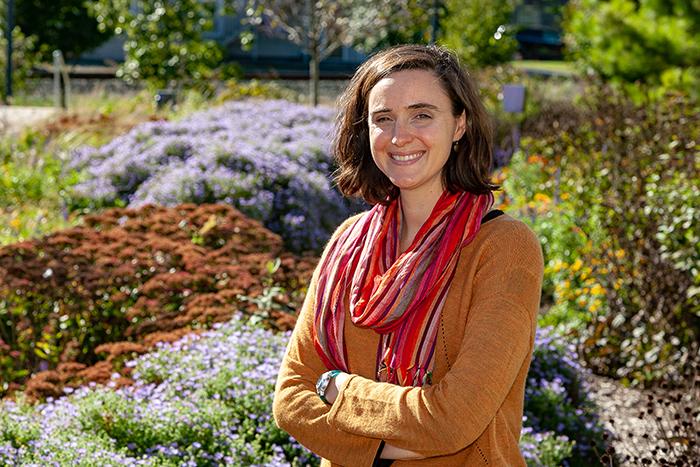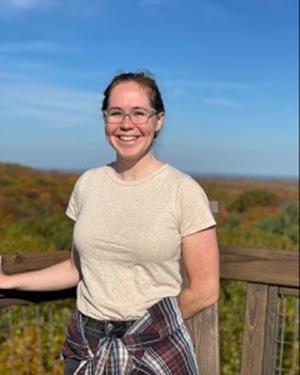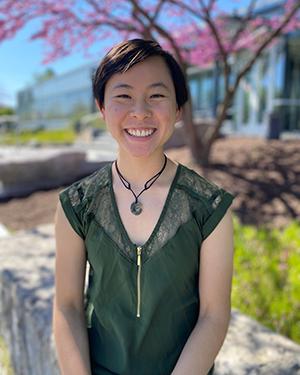Dickinson Student-Faculty Research at Forefront of Fight to Save Bees

Assistant Professor of Environmental Studies Maggie Douglas. Photo by Dan Loh.
Data and Coding Critical to Understanding Pesticide Effects on Pollinators
by Craig Layne
Whether it’s apples from a farmers’ market, your morning cup of coffee or a sizzling stir-fry in a restaurant, there’s a good chance a pollinator helped grow the food you’ve enjoyed today.
“Many crops require insects, like bees, to pollinate them to produce fruit and seeds,” explains Assistant Professor of Environmental Studies Maggie Douglas. Despite their critical role in agriculture—and human survival—pollinators are in decline due to a combination of stressors, including climate change, habitat loss and invasive species. Pesticides are suspected as a factor, too, but have been challenging to study due to a lack of information on their distribution in the environment, Douglas says.
Now, Douglas’s advocacy for the restoration of a key pesticide database—and her collaborative research with colleagues and students—is drawing national attention from both the media and government in a win for scientists and, hopefully, for pollinators, too.
Student-Faculty Research Digs Into Databases
Tracking pesticide use in the U.S. involves what Douglas calls “dizzying complexity,” with different pieces of the puzzle provided by databases from the U.S. Geological Survey, the U.S. Department of Agriculture and the U.S. Environmental Protection Agency.
“It’s not glamorous,” jokes Douglas, explaining that the work is critical to pull multiple threads together to get a comprehensive understanding of pesticides on the landscape. Pollinators, like bees, can pick up pesticides from crops, many of which sprout from seeds already pretreated with pesticides (they can also pick up pesticides from the soil). Because many bees travel over long distances to forage, understanding which pesticides are used where is critical to understanding their impact on pollinators, Douglas says.

Paige Baisley '20
Douglas enlisted the assistance of Paige Baisley ’20 (environmental science & food studies) and Sara Soba ’21 (environmental science) to compile and analyze the reams of data. It was a job that required them to learn how to code, something that would come in handy for both students’ later careers.
“I still talk about how I learned to code using [the programming language] R, which is not the friendliest coding language,” Soba says. Now, in her job as a senior technical analyst at Enterprise Knowledge, a company founded by fellow Dickinsonian Zach Wahl ’98, Soba explains the importance of data to stakeholders all the time. “It was a really valuable learning experience to get to combine all these things and try to tell a story with all this solid information.”
“Not only was it a good experience at the time, but now in graduate school I’m coding to do statistics all the time,” says Baisley, a graduate research assistant at Michigan State University working toward a Ph.D. in crop and soil science. “It gave me a real step up.”
The trio and other scientists published their research in a paper for the journal Scientific Data called “Putting Pesticides on the Map for Pollinator Research and Conservation,” which created maps to predict pesticide loading across the contiguous United States.
Revealing Pesticide Patterns
Using the earlier research as a foundation, Douglas co-authored an article in the journal Proceedings of the National Academy of Sciences with researchers from the USGS and other institutions, specifically examining the western bumble bee, which has declined dramatically since the 1990s and is being evaluated under the Endangered Species Act.
“What I’m most excited about since Paige and Sara worked on this project is that our research has attracted attention in federal efforts for pollinator conservation,” says Douglas. "Our results are being provided to the U.S. Fish and Wildlife Service, and they will use it as they decide whether this species should be listed [as threatened or endangered]."
The group's research revealed that while climate change is a substantial factor affecting the western bumble bee, the class of pesticides called neonicotinoids, or “neonics,” is also significantly related to its decline.
“This was the first time that connection had been demonstrated for this species, or for any U.S. bee species at this continental scale” Douglas says. "And the pesticide part of the study was only possible because of the work that Sara and Paige did with me earlier to create this mapping methodology."
Typically applied as coatings on crop seeds, neonics include the most widely used insecticides in America when measured by land affected. And as Douglas points out, in talking with vaunted environmental reporter Dan Charles for a feature in the Food & Environment Reporting Network, “The neonicotinoid research literature at this point is vast… Some of the strongest negative effects that we see are on bumble bees.”
Making a Buzz for Better Data

Sara Soba '21
Understanding the impact of neonics on the western bumble bee would not be possible without the data Baisley and Soba helped aggregate and analyze, but when one of the sources of that data was threatened, Douglas sprang into action with scientists across the country.
The USGS planned to curtail its Pesticide National Synthesis Project from providing information on 400 pesticides annually, to covering just 72 pesticides with updates once every five years.
“This has been the most comprehensive picture of pesticide use in the country for over a decade,” Douglas says. “The loss of this essential information is something I think all of us should be concerned about.” Douglas and her colleagues met with USGS to encourage the agency to restore the database to its full scope, and she was among more than 250 scientists and 120 organizations, including the Center for Biological Diversity, pushing the agency to reverse course.
In February 2024 the USGS did just that. MIT’s Undark magazine detailed this reversal, quoting Douglas and explaining that she was part of a group that put together an informal survey to demonstrate how people outside the USGS used the database in question. It noted that "in just two weeks ... the survey generated more than 100 responses from people working in agriculture, conservation, public health, farmworker safety and water quality.”
“This is a really important resource to be protected,” Douglas says, emphasizing that without the USGS’s data, Soba and Baisley would have had a tougher time developing the mapping tool that underpins so much critical research.
“I knew it was going to be a great tool, and I’m really happy to see that it’s getting used,” says Baisley. “I was hoping that it would be as impactful as it has been.”
TAKE THE NEXT STEPS
Published April 9, 2024